-
Blog


Corporate Office
Pushpak
18/1, Deodar Street
Kolkata - 700 019
India
Know More
04-08-2025
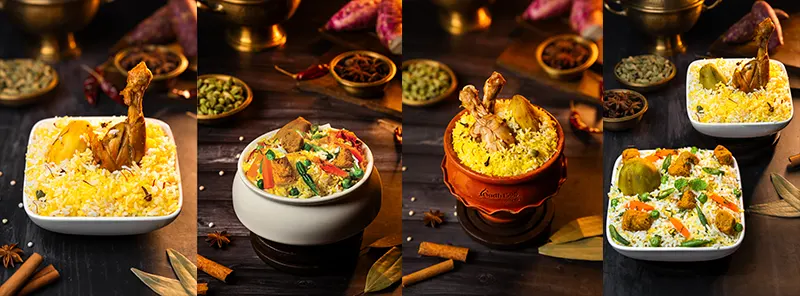
Let’s ask you a quick question to start off this blog - Which is the single most ordered Indian dish globally? Full marks if you said ‘Biryani’. Now, if we were to put together a list of Indian food “blockbusters”, this popular rice dish would rank consistently at #1. Biryani continues to receive widespread love and adulation and frankly, at Oudh 1590 it brings a big smile to our faces each time to watch generations walk into our restaurants and order a biryani.
Over the years, however, we realized that biryani was scripted to leave out diabetics. Many guests would sadly – and helplessly – give it a miss. Unfair, we admit. Reason? The traditional biryani usually made with rice and potatoes has a high glycemic index, meaning it can cause a rapid spike in one’s blood sugar levels.
We couldn’t let this pass. Something had to be done…
Oudh 1590 introduces a Culinary Breakthrough
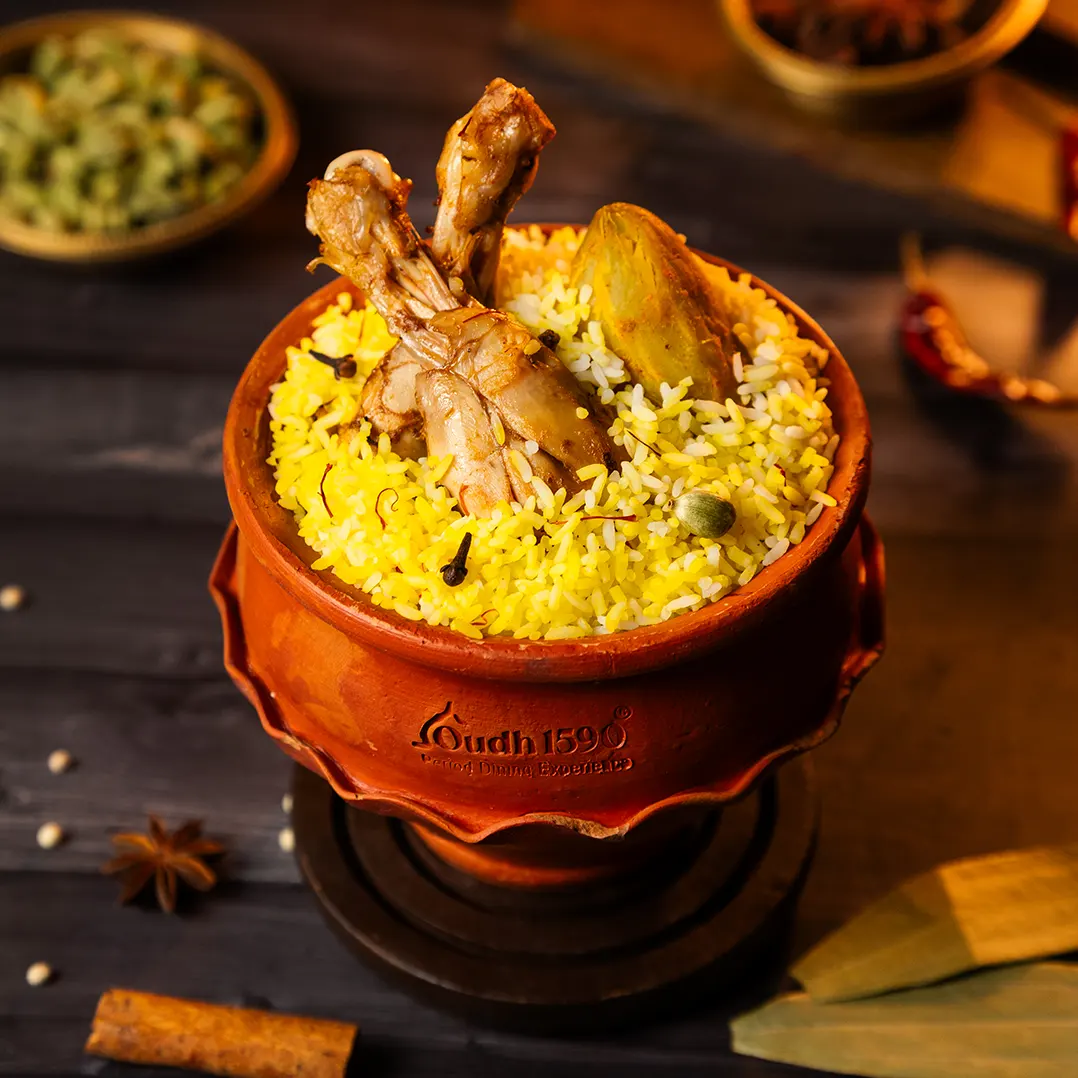
So, we asked ourselves: Can we create a biryani that is diabetic-friendly? That’s a neat balance of mindful indulgence and healthier food options in one go and offers a mindful eating indulgence. Ergo, the world’s first diabetic-friendly biryani by Oudh 1590.May we take pleasure of introducing the culinary breakthrough that people with diabetes can enjoy without the guilt. Just walk into any Oudh 1590 and check out the new addition to our menu.
Nutritional Values and Great Taste now go Together: Here’s How
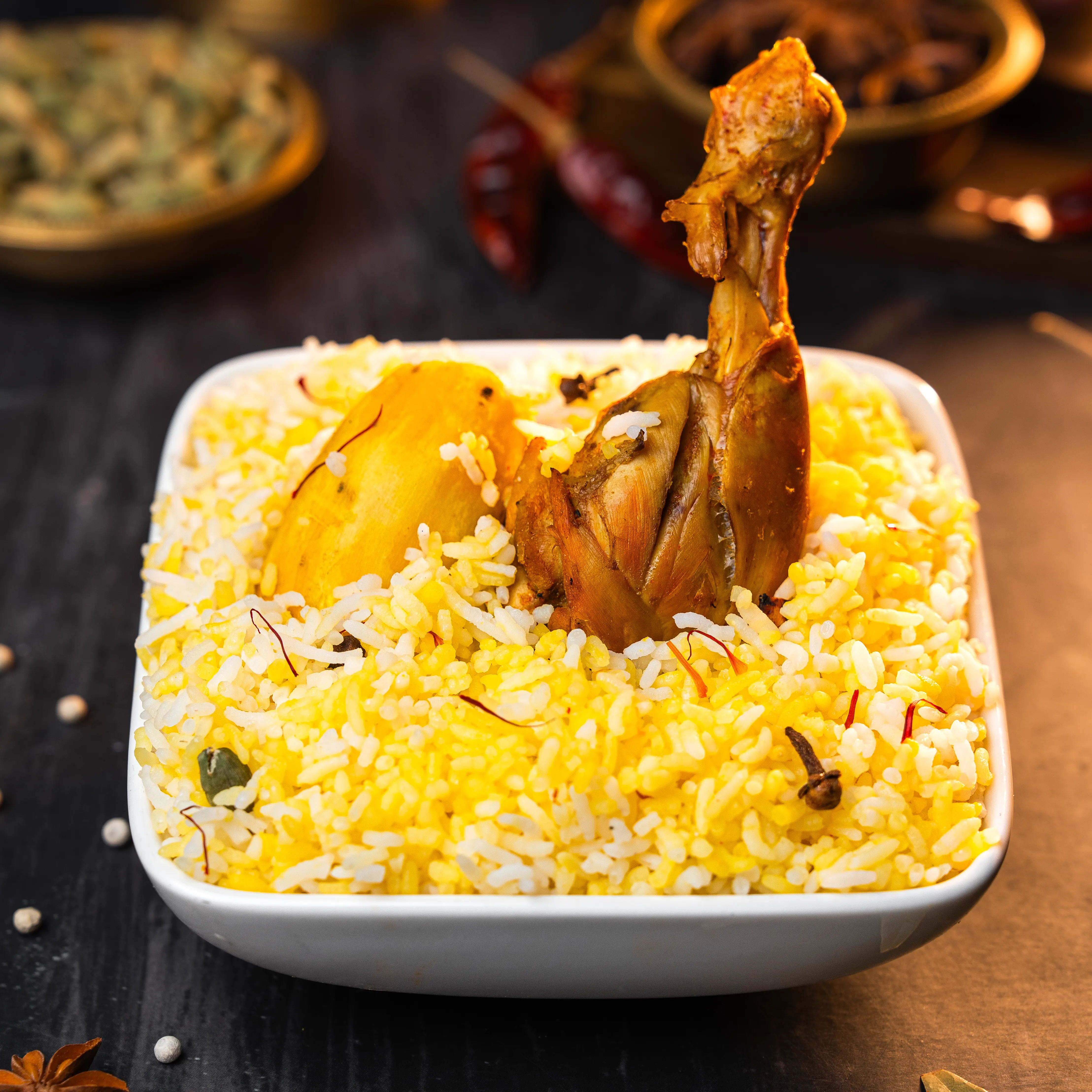
How was the diabetic-friendly biryani created? Well, the traditional biryani was mindfully tweaked after a good deal of thought and research to transform it into a healthier option for those shying away from the original richly-spiced rice and potato affair with succulent pieces of mutton nestling within. And why wouldn’t they - because most ingredients carry high GI and therefore are best avoided by diabetics.
In the new variant, we substituted mutton with a leaner option. We also created something for vegetarians so they wouldn’t feel left out. The new dish has been given a more fibrous twist to make it friendlier for the gut. The rice we use has been pre-treated. Potatoes have been switched with a healthier alternative.
But the ensuing taste is so close to the original that you won’t miss it much. We’re not giving away all the secrets here because we urge you to try it and discover for yourself. All we are saying is that the two innovations – Diabetic Murgh Biryani and the Diabetic Subz Biryani were created keeping in mind the alarming jump in diabetes cases across the nation without letting go of what Awadhi biryani is essentially about.
Keeping the Flavour
Oudh 1590 founders and brothers, Shiladitya and Debaditya Chaudhury believe that an important characteristic aspect of Awadhi biryani is its truly royal look and flavour. Healthier and guilt-free options are the demand of the day, but they shouldn’t come at the cost of its sumptuous taste, right? Keeping the flavour was the mandate and the team rose beautifully to the challenge.
Green Tick from Dietician: Oudh 1590’s Diabetic-friendly Biryani

Oudh 1590 worked closely with Dt. Nidhi Prakash, M.Sc. (Dietetics), IDF Certified in Diabetes (USA), a renowned dietician and certified diabetes expert to create the new variant of diabetic-friendly biryani. Traditional biryani is often off the plate for diabetics owing to its ingredients like white rice, potatoes and mutton which have a high glycemic index and are tougher to digest with weakened gut health. They have been switched with healthier options approved by her.
Each plate comes in a 400g portion with a suggested serving size of 200g that aligns with dietary recommendations. It’s suitable for both Type 1 and Type 2 diabetics.
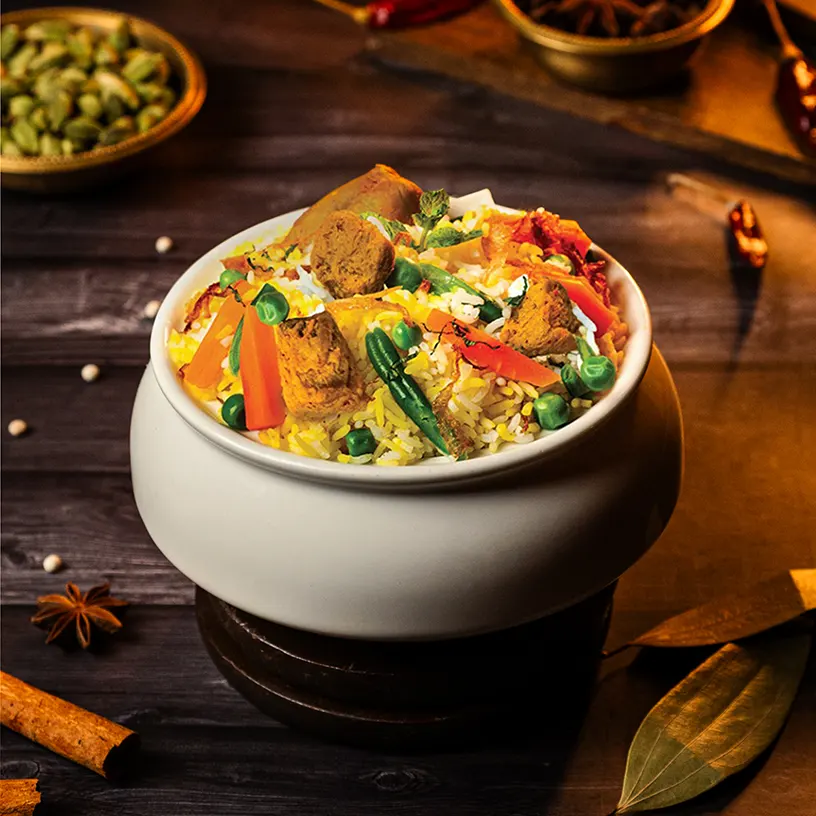
A Great Option for Every Health Enthusiast
The all- new diabetic-friendly biryani from Oudh 1590 is a great choice for just about anyone who is mindful about health. Think weight watchers, gym freaks, those with compromised health, or the elderly.
Available Now!
The diabetic-friendly biryani is available across all Oudh 1590 outlets for dine-in guests only. Choose from the non-veg Diabetic Murgh Biryani or veg Diabetic Subz Biryani options that balance nutrition with great flavour beautifully.
We are Waiting to Hear from You
Now that we have presented the world’s first diabetic-friendly biryani to you at Oudh 1590, we are waiting to hear what you think of it. Is it perfect the way it is? Is there something new you would like to add on? Connect with us on Facebook at Oudh 1590 or Insta handle Oudh 1590. You may also mail us at platterhospitalitypvtltd@gmail.com
08-07-2025
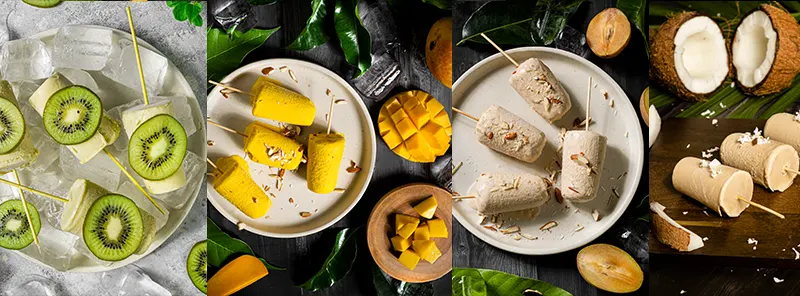
Originating from the Persian word meaning “covered cup”, Kulfi is believed to have been born in the royal kitchens of the Mughal empire in the 16th century. Sinfully dense and creamy, this frozen dessert is well known for its rich texture and unique flavours. It is easily available in most places across the country and has its own dedicated fan following. Now, Oudh 1590 has gone ahead and upped the game of Awadhi period dining experience by introducing a range of fruit-infused Kulfis for dessert in its menu. So, you just stay cool, no matter what!
Kulfi is a Dessert Steeped in History – Don’t take Kulfi lightly, even if it may be selling at a wayside stall. This fabulous frozen treat with a distinct desi vibe is almost 500 years old! Kulfi first appeared on the face of the Earth in the Mughal era. A wizard in the royal kitchen procured thick sweetened milk, added plenty of crushed ice, and natural flavours like rose water and saffron, and slivers of nuts and let the mixture freeze well in special moulds. That’s it! Kulfi appeared to delight mankind. Mind you, Kulfi was never an aerated dessert like ice-cream, it came with a more coarse, denser texture which it still holds on to. This traditional frozen dessert evolved over the years never dipping in popularity and at Oudh 1590 we’ve just spun some magic into it for you.
At Oudh 1590, We gave a Brand-new Twist to this Heritage Treat – At some point, we’ve all treated ourselves to the traditional Kulfi flavours – kesar- pista- badam- gulab, but at Oudh 1590 where we take pride in doing things differently keeping the time-tested core, we’ve given a brand-new twist to the timeless Kulfi. At Oudh 1590, our Kulfi comes with all-new energy bursting with vibrant fruit extracts. Check our latest menu for the latest drop of Kulfis with real fruit. Welcome to deliciously fresh and flavourful desserts!
All Real Fruits, No Flavourings – We’re here for the real stuff, and our chefs will turn up their noses at anything that is anything less. No flavours in our Kulfis, we’re fearlessly real, thank you very much. At Oudh 1590 we bring to you the fruits of the season snuggly wrapped in dense sweetened milk frozen just right for a heavenly bite into creamy tenderness. Celebrate the awesomeness of a fresh fruit Kulfi at Oudh 1590.
A Treat for the Eyes (and Tastebuds) – Radiant golden-yellow alphonso mango, bright red strawberry, seductively dark purple jamun, delicately pale lychee. They’ve made a place – and name – for themselves in Oudh 1590 Kulfis’ list. Go ahead, check the entire range, pick your favourite fruit of the season and slurp away on Oudh 1590’s divinely deliciously traditional desserts.
Kulfi Has its Own Stories - Did you know this refreshing and delicious dessert comes with its own tales and backstories? Kulfi appears regularly on the menu at Rashtrapati Bhavan events being a hot favourite of the famous and elite folks invited to dine there. We’re nodding in awe and admiration. The svelte Vaani Kapoor has confessed her love for kulfis among other Indian desserts. Virendra Sehwag, the famed cricketer, once captioned his social media post – Whatever be the match situation, stay calm and eat your kulfi.
The Dessert Secret that Works for Every Generation – Most food will have a favourite generation that roots for it. But, hey presto, there’s one that works perfectly for every member of the family. Kulfi, of course. Let us treat you to this decadent melt-in-the-mouth traditional dessert at Oudh 1590 where the all-new menu will both surprise and excite you.
The Perfect Dessert in our Weather – Kulfi was made for Indian weather conditions and we know just what that means. No offence meant but butterscotch-swirled, brownie-blasted concoctions may not work when the sun has been beating down all day long. What we need is a generous gulp of frozen sweetened milk sliding down our gullet. In other words, only a delicious good old Kulfi will do! Step in Oudh 1590 where we know exactly how you feel and will treat you to the bliss you’re craving.
The Right Dessert to End Your Awadhi Feast – Now that you’ve come to the end of the main course of your royal Awadhi meal, you would like to end with a suitably royal dessert, wouldn’t you? Treat yourself to Oudh 1590’s ambrosial Kulfi with abundantly fruit-filled extracts. Did we hear someone say, “Laajawab”?!
09-06-2025

At Oudh 1590, we serve authentic period cuisine. But, what’s equally important to us is that you take away the delightful experience of period dining when you come to us. For this, we pull out the stops by taking you on a journey of the Nawabi era with all the opulence and regality while you enjoy your food.
Step inside Oudh 1590 and you are transported back to the days of the royals. Enjoy the the grandeur against a rich cultural tapestry of art, architecture, and music - distinctive hallmarks of the Nawabi period. Soak into the unmistakable hospitality and refined dining etiquette that elevate the experience even further.
What Makes Dining at Oudh 1590 Unique?
May we say at Oudh 1590, we go beyond making it simply a dining experience– we create a multi-sensory immersive journey that goes beyond period cuisine by bringing together charming elements of Nawabi era dining.
Ethnic Period Tableware – Rooted in India and made for traditional Mughal cuisine, at Oudh 1590 you are served in ethnic period tableware. Elevate every dining experience while you are here.
Authentic Period Décor - From carved diwans and jharokhas, every piece of furniture at Oudh 1590 stays true to the traditions of the erstwhile Nawabi era with its classic detailing, rich upholstery, and ornate patterns.
Hand-Painted Walls and Royal Artefacts - The interiors of every Oudh 1590 restaurant bring alive scenes of a bygone era with intricate wall art and expressive portraits and scenes. Feast your eyes on vintage chandeliers and artefacts blending history with visual storytelling as you dine.
Traditional Layout with Soft Lighting – The lighting at Oudh 1590 is created to be reminiscent of the fabled mehfils and darbars. These deeply artistic gatherings allowed you to indulge in the cultural experiences of the time. The traditional layout is thoughtfully created for an intimate and immersive dining experience.
Soundscapes from the Past – Soothing Hindustani classical music plays in the background at Oudh 1590, transporting diners right back to the age of nawabs, poets, and courtesans.
At Oudh 1590, We Weave Memories Far Beyond Food
Every dish tastes better when experienced in the unique immersive setting. So, pick from the delectable kebabs, biryanis, and desserts to make it a delightfully royal ritual and return back with a memorable experience each time. Just like our guests who made personal memories for a lifetime with Oudh 1590’s heritage dining experience. Here are some of them -
Nihari. The staff gifted them a handwritten Urdu menu with their names, a royal keepsake to make their royal proposal immemorable.
*Names have been changed to protect the privacy of our beloved patrons.
28-03-2025

We take special pride in announcing that this unique slow-fire cooking method called Dum Pukht finds its way every day into Oudh 1590’s kitchens to produce the most tantalizing range of biryanis for our diners.
Food historians believe that Dum Pukht’s sources lie either in Persia or central Asia and that it grew massively in popularity during the Mughal period in India. The style of cooking seems to have reached its zenith in the period of the Awadhi nawabs who were no simple eaters themselves and insisted on just the right aromas and flavours in the dishes that came out of their royal kitchens.
Biryani Tales
Although the stories behind the origin of biryani are countless, there is one that stands out and is quite popular amongst biryani and food history lovers alike. It is associated with Nawab Asaf-ud-Daulah. It is said that the Nawab Wazir of Awadh (Oudh) who was a big patron of the Lucknowi culture and unique style of poetry, introduced a charity scheme for his people during the great famine of 1784. The Nawab Wazir decided to build an architectural marvel and required manpower for it. The famine had left the people with the need for food and money and many people readily joined work.
As per the orders of Nawab Asaf-ud- Daulah, at the end of the day the workers were served a wholesome dish made of rice, meat and vegetables; cooked in a dough-sealed vessel for hours. The dish was filling, flavourful and delicious.
One day, while he was out on his regular rounds, the heady aroma of the dish floated across to the Nawab’s nostrils. It must have sent a thrill of excitement down his spine because he immediately ordered his royal ‘khansamas’ to rustle up the same dish for him.
The royal kitchen made the same dish but took care to include some lavish ingredients and spices befitting the royal diner. After the meal, Nawab Wazir was left speechless. Gradually, the dish migrated to the royal kitchens of the Awadh court where the high and mighty were served.
What is Dum Pukht?
Essentially, an Indian (Awadhi) style of cooking, Dum Pukht is essentially an elaborate cooking style that takes cares to ensure that flavours are released extremely slowly from the food and aromas remain bound into the vessel as it is covered and sealed with dough. The cooking technique involves slow cooking for many hours on a low fire in a round heavy-bottom vessel sealed with dough. It allows the dish ‘to breathe’ and keeps all the flavours sealed within, imparting incredible aroma and flavour of the cuisine. When it is done, this delicacy may be served in the clay vessel in which it has been cooked, and the seal of dough that turns into a pastry crust is ripped off to reveal the magic within. The Dum Pukht style of cooking has worked its magic into countless hearts.
Oudh 1590’s Biryanis – Bringing Alive the Legacy Each Time
Brothers and founders, Shiladitya and Debaditya Chaudhury, have brought alive the legacy of the royal days of the Nawab Wazir at Oudh 1590. This chain of period restaurant that recreates an exemplary ambience together with authentic cuisine of the day was formed after their many visits to Lucknow and countless days of pouring over Awadhi cuisine and culture.
Presenting here, the range of Dum Pukht biryani delicacies that are a labour of love and created for the discerning diner at Oudh 1590.
For the entire range of Awadhi delights on offer, click on the all-new menu.
• Gosht Awadhi Handi Biryani – Long grain fluffy rice is cooked with tender mutton pieces the Dum Pukht way to create this flavourful biryani that is served in Oudh 1590’s signature earthen vessel.
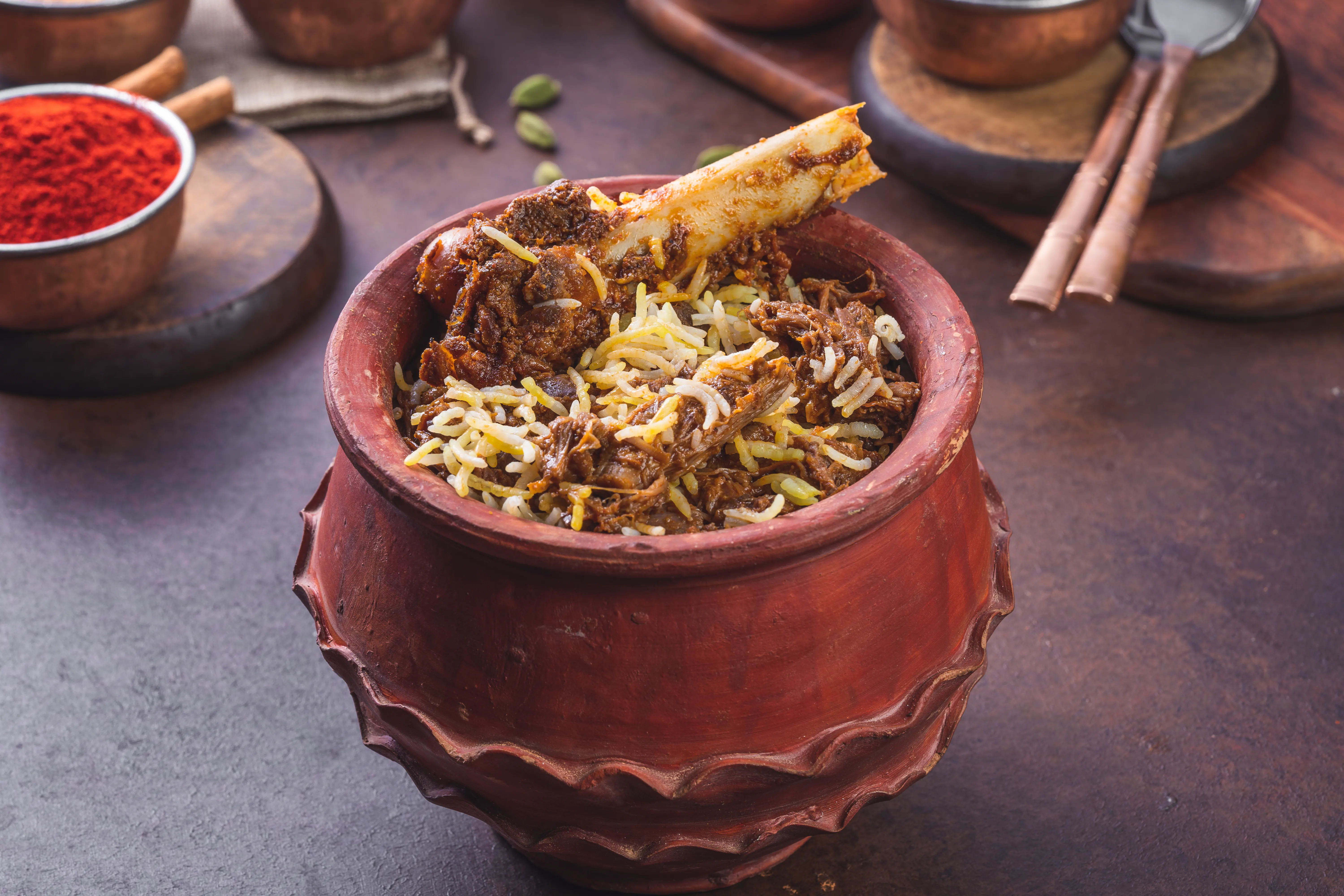
• Oudh Special Raan Biryani – Cooked in the Dum Pukht style, this true royal Awadhi delicacy consists of rice with leg of mutton drenched in the aromas of rich spices. It is served in Oudh 1590’s special earthen handi and best had within 45 minutes of being delivery.
• Jheenga Biryani – Light and fluffy rice with tender fresh river prawns cooked the Dum Pukht conjure up this flavourful dish.
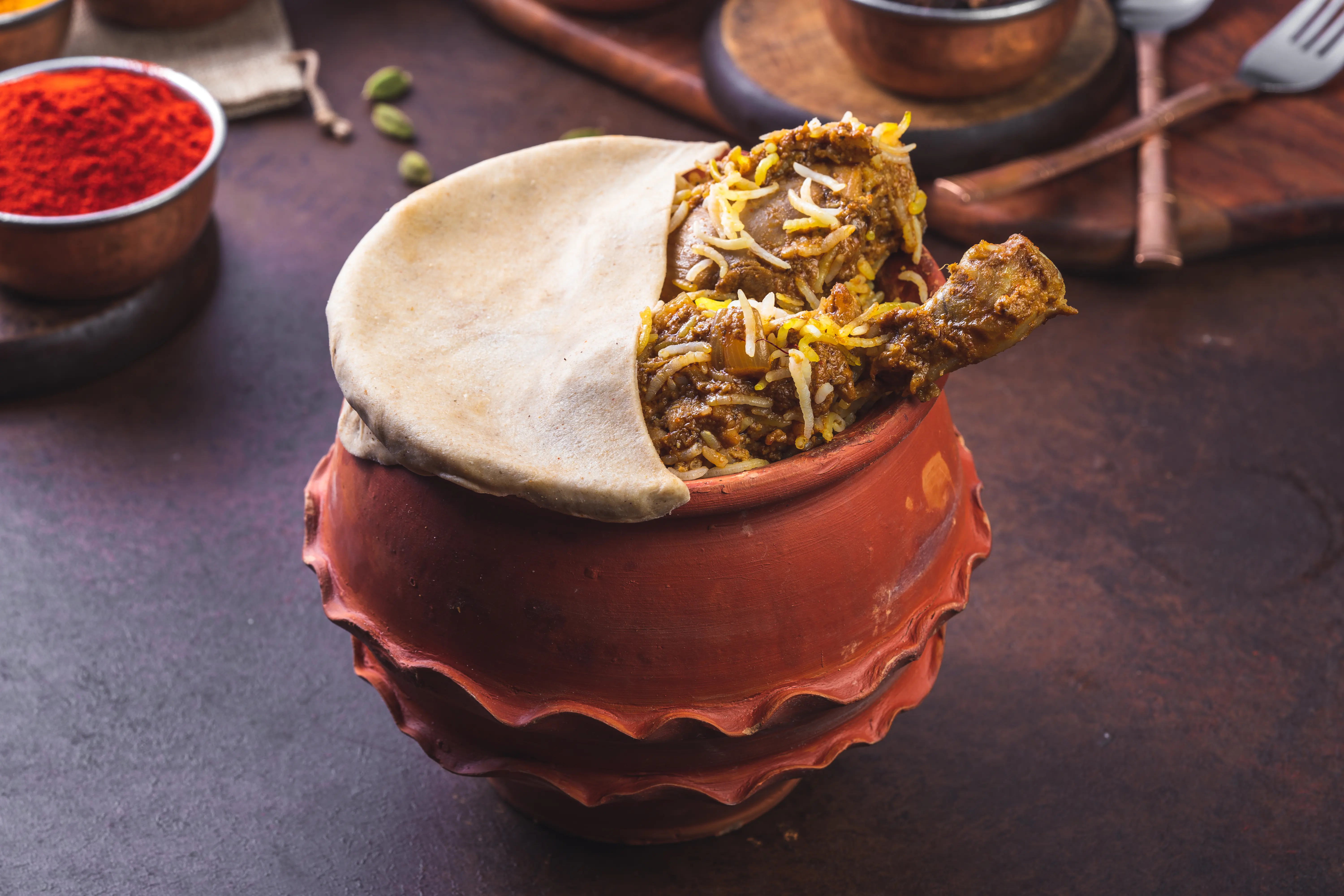
• Murgh Purdah Biryani – This delectable Awadhi delicacy is a house-special where our chef infuses aromatic spices to create an out-of-this-world rice and chicken biryani in the fabled Dum Pukht style. The earthen pot is sealed in a dough and has to be cut through to experience this delicacy.
• Moti Biryani – A confirmed favourite of hundreds of Dum Pukht aficionados, this Dum Pukht dish comes with fragrant fine rice and minced mutton balls bursting with Awadhi flavour. Believed to be a favoured dish of the royals of yesteryears.
• Awadhi Palak Biryani – Refreshing aroma and the fresh crispy taste of spinach cooked with rice in the Dum Pukht method create this delicious and out-of-the-ordinary dish.
• Subz Soya Biryani – Bite into this vegetarian Dum Pukht delight of fine rice, soya balls, and mixed vegetables.
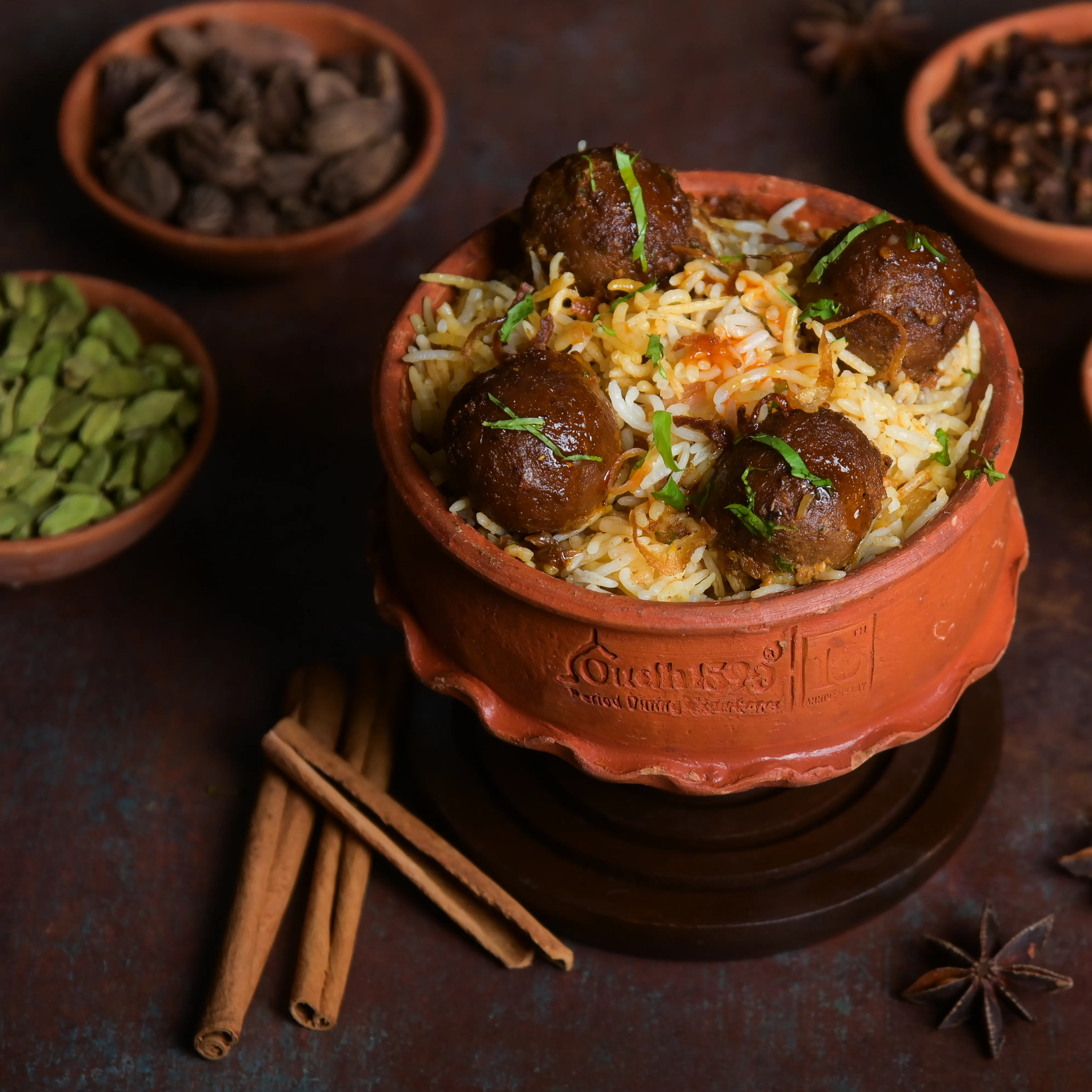
• Mushroom Moti Biryani- A fragrant Awadhi delicacy featuring succulent mushroom pearls simmered with aromatic spices and saffron-infused flavourful rice.
24-02-2025

Oudh 1590, the city’s first period dining restaurant houses some seriously delicious gourmet favourites. It was created to serve authentic, high-quality Awadhi (Lucknowi) food at affordable prices to suit a range of pockets. Today, the multi-locational chain of Oudh 1590 restaurants has made a name for its approach that takes you right back to the regalia of its erstwhile Nawabi rulers. Indulge in Oudh 1590’s carefully-selected menu and let an assortment of flavours, textures, and ingredients explode in each mouthful.
Helmed by brothers and founders, Shiladitya and Debaditya Chaudhury, Oudh 1590 was created after their many visits to Lucknow and countless days of poring over Awadhi cuisine and culture. The duo’s vision remains to provide exemplary and authentic Awadhi food, ambience, and décor to diners at Oudh 1590.
The ambience and décor guarantee a stunning throwback to the royal days of Nawabs. When you step inside any of the outlet, you find the signature period woodwork furniture, exquisite Mughal wall art, and elegant bronze serve-ware. Don’t miss the ghazals and thumris either, played to round off the atmosphere perfectly.
But it’s probably the food and the service that have made Oudh 1590 so popular. It’s okay to say that the place does not disappoint when it comes to food, and regulars have drawn up their list of traditional dishes to try here.
Here’s the list of Oudh 1590’s unmissable signature dishes that make it the best Mughlai/Awadhi restaurant in Kolkata –
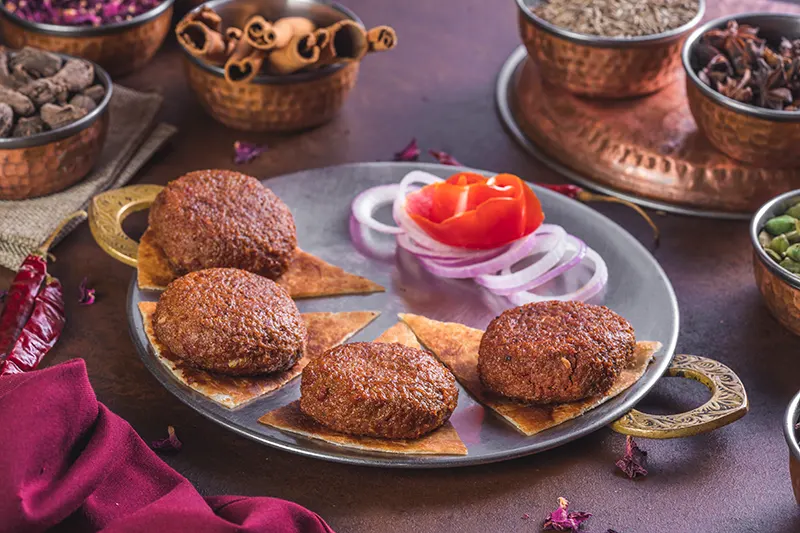
Gosht Galawati Kabab with Lucknowi Paratha – The Gosht Galawati Kabab gets the top spot. A whopping 6,00,000 Oudh 1590 Galawati Kababs were relished in just one year by diners. That’s a cool 1644 Galawati Kababs on a daily basis. Can someone please give our chefs an award?! A favourite through the year, this Awadhi delicacy is created with a fine mutton paste marinated with special spices to impart its distinctive taste and then shallow fried. It pairs best with a piping hot Lucknowi Paratha.

Oudh Special Raan Biryani – The famed Dum Pukht style of cookery comes into play to create this royal Awadhi dish where a tender leg of mutton is served with fine aromatic rice. Served in Oudh1590’s signature earthen-ware.
Murgh Irani – This house speciality has tender pieces of chicken with bone cooked in a rich tomato-based gravy with an endearing sweet-sour taste.
Nalli Nihari – Mutton shanks sunk in a delightful gravy of Awadhi spices create this dish that is in equal parts comforting and celebratory.
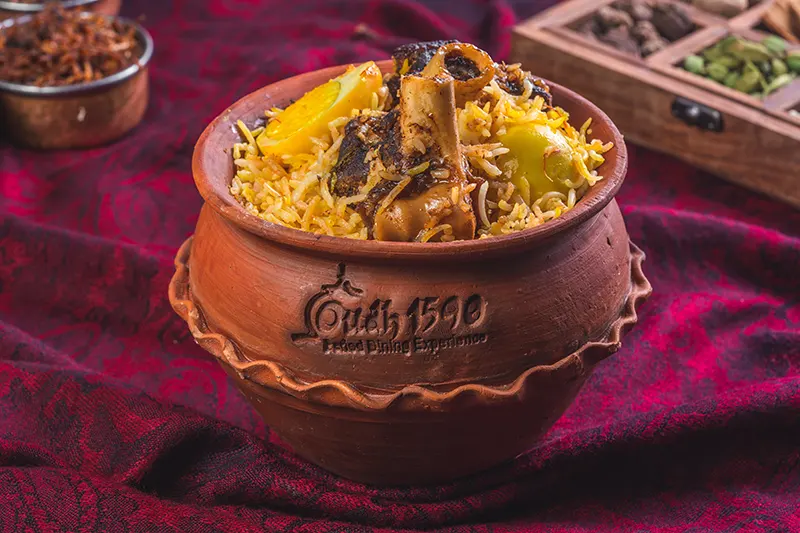
Gosht Awadhi Handi Biryani – The distinctive Dum Pukht style of cooking with succulent mutton pieces in fine rice and an unmistakable Awadhi flavour. Served in Oudh 1590’s earthen-ware handi
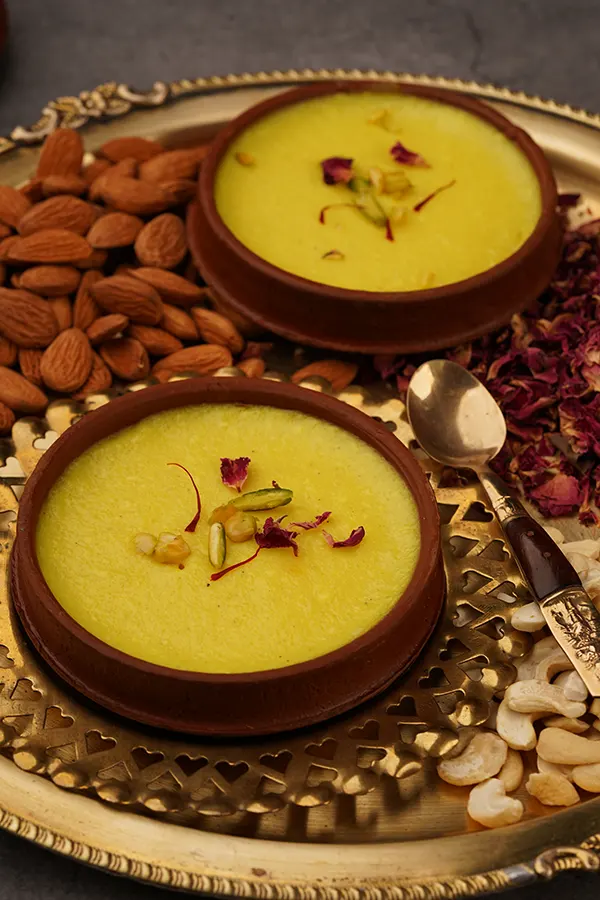
Murgh Awadhi Handi Biryani – A stand-out biyani dish served in an earthen pot with dopamine-inducing aroma. It is a blend of fine rice cooked in the Dum Pukht way with the juiciest pieces of chicken nestling within. Pure Awadhi flavour!
Phirni – The wizardry of rice flour, sugar, rich cream and heady saffron delight in Oudh 1590’s Phirni, the traditional dessert that has scores of fans across ages
Oudh 1590 with its thoughtfully-created menu manages to excite and delight diners who drop in to celebrate their special moments or simply to tuck in wholesome Awadhi cuisine. The richly-awarded restaurant chain remains a must-visit for all lovers of Awadhi fare.
21-01-2025
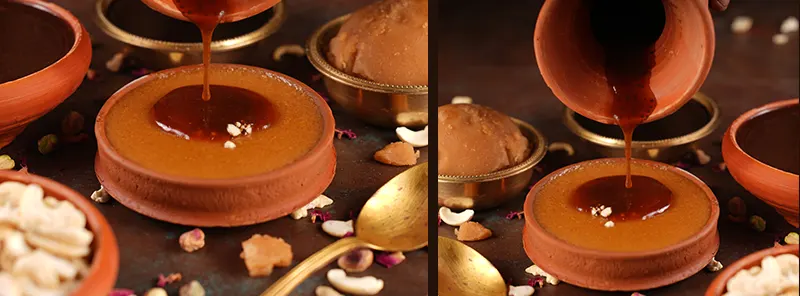
Here's good news for all fans and followers of Nolen Gur, the unmistakable harbinger of winter in the city. This winter, Oudh 1590 presents the Nolen Gurer Phirni, a creative twist of the original Phirni, a round-the-year dessert favourite at its outlets. The new item on the menu is a sweet union of the two.
Nolen (or Natun) Gur is the heavenly golden-brown date palm jaggery that makes its appearance as the mercury drops in the region. It forms the chief ingredient in most winter confectionery from Nolen Gurer Payesh (Kheer) to Joynagarer Moa and many more along the winter sweets' trail that we love to indulge in.
Phirni holds its sway as the classic slow-cooked rice pudding made with the fragrant Basmati rice, rich creamy milk, and a sweetener that is usually sugar which has been replaced with Nolen Gur in the dish.
Says Shiladitya & Debaditya Chaudhury, founders of Oudh 1590 chain of restaurants and avid gastronomes themselves,"At Oudh 1590, this winter we thought of introducing a new entrant in the desserts' menu by combining two classics whose popularity continues undiminished over the years – Nolen Gur and Phirni. Needless to say,the medley dish is already a preferred choice of our guests."
Chefs at Oudh 1590 are already upping their game to infuse the flavour of Nolen Gur after the winter season gets over so diners can dip into their servings of Nolen Gurer Phirni all year round.
As India's first period dining restaurant for customers who are looking for authentic Nawabi cuisine without burning a big hole in their pockets, Oudh 1590 offers Awadhi food from starters to desserts in tastefully done décor that takes you right back to the traditional culture of the nawabs.
Check out Oudh 1590's menu for the entire lowdown on the range of thoughtfully-chosen and prepared dishes.
08-04-2024

When you dig into your plate of favourite Biryani next time and let a hundred sensations explode inside you, the timing may not be quite apt to pause and delve into the history of the beloved dish of millions. However, we suggest you reflect for a few moments on how the delectable dish arrived from across the tall mountains and made a permanent place in the hearts of countless Indians.
While there are many speculations about how it arrived here, the most widely-accepted belief is that Biryani (or Biriyani) came with the traveller-businessman all the way from Persia. Biryani, as it goes, originated in Iran. The name Biryani can be traced to the original Persian "birinj biriyan" meaning ‘fried rice’. In Iran, the ‘deg’ (pot) is put on ‘dum’ (slow cooking to allow the marinated meat to cook in its own juices and perfectly blend with the layered cereal and aromatic substances), and the rice is gently fried. The doyenne of Islamic cooking in India, Salma Hussein, however, informs the biriyani sold on the streets in contemporary Iran interestingly no longer contains rice but has evolved into succulent chunks of meat cooked in an envelope of rumali roti (paper thin bread). In India, though, biryani is the quintessential celebratory dish made of fluffy fine rice, tender succulent meat pieces, and plenty of aromatic spices cooked in a special distinctive method.
As far as the South goes, there is no clear evidence that biryani first came to this land with the Moguls. In fact, it is far more likely that it travelled with pilgrims and soldier-statesmen of noble descent to the Deccan region in south India. Much later, the dish meandered along less-travelled routes in the region, along the seaboard and the hinterland of the peninsula, happily absorbing local influences to tickle regional palates.
Notably, there is mention of a rice dish known as “Oon Soru” in Tamil as early as the year 2 A.D. This dish was composed of rice, ghee, meat, turmeric, coriander, pepper, and bay leaf (nearly all ingredients of the modern-day variant of South Indian biryani) and was prepared as a wholesome meal to feed military warriors.
The famous traveler and historian Al-Biruni has precise descriptions of meals at the courts of Sultans who ruled parts of India prior to the Mughals and some of them also contain mention of rice dishes very similar to the Mughal biryani. However, there is no doubt that the dish came to be cooked in India ahead of the Mughals and the Islamic Persians inspired and popularised the dish.
Biryani truly represents the vibrancy and diversity of this nation in its own way. Over time, innumerable variations of this one-pot meal have evolved, each having their own die-hard band of fans. This soul-satisfying dish that blends without fuss in anything from a special Sunday lunch, a celebratory football victory, a community meal, or comfort food on a bad day has been classified into several distinct categories. What essentially emerges is that it has adapted itself to regional palates and local ingredients and come away as a favourite everywhere. You want your Biryani in a specific way – guess what, it already exists!
Here, we present the more well-known members of the tribe:
The popular Ambur biryani is sure a treat for the taste buds. Essentially hailing from South India, Ambur biryani has been around since the 1890s and is still continues to woo people with its irresistible appeal. What started as a traditional family by Hussain Baig in 1890 dish has now evolved over time to become the favourite dish of a huge race of people. Ambur biryani is known for its mild rice flavour, marinated and mixed with authentic spices and succulent meat pieces all blended together just right.
Every biryani lover worth his taste buds must have sampled this at least once. Hyderabadi Biryani is the most popular Andhra dish that is cooked in the dum method and has also come to be widely known as the Hyderabadi dum biryani. The dish is steamed at a minimal temperature after cooking and this is a distinct speciality of this biryani. Some cooks will even place the dish of biryani in a vessel of boiling water, and allow it to get steamed perfectly from the emerging vapours. The final output gives a nicely soaked and mellow taste to the rice.
Thalassery biryani is a popular biryani dish in Kerala and is widely relished by locals as well as ardent biryani lovers elsewhere. It is an interesting blend of several cuisines like Arabian, Persian, Indian, and European. This biryani is made of Jeerakasala rice that is highly aromatic. Thalassery biryani is rich with pure and aromatic spices, often used whole or coarsely ground, that blend perfectly with the Jeerakasala rice.
Bhatkali Biryani is a favourite dish of the people on the coastal region of Karnataka. It is stated that this dish was brought by the Persians and left behind for us to cherish for ages. The popularity of the Bhatkali Biryani is that no oil is used in its preparation. Unlike other biryanis, this Biryani is white in colour like plain rice, with just a few streaks of orange. Bhatkali biryani has a generous topping of crunchy fried onions and garlic.
The Chettinad Biryani uses chicken as its preferred meat. It is aromatic and flavourful with chicken pieces, freshly ground spices, and coconut milk. It commonly uses the Seeraga samba rice found easily in Tamil Nadu that makes it delicious. This variant can also be made using mutton instead of chicken.
In India, the Kampuri biryani is a distinctly Northeastern dish. Although it is not too popular across the country, it is a delicious dish that anyone can enjoy. You may use both basmati and regular rice for preparing the Kampuri biryani. The Kampuri biryani is a mix of vegetables like peas, carrots, potatoes, bell peppers.
Sindhi Biryani is widely known as Pakistani Biryani and is always on the food list of Sindhis. Sindhi Biryani is a little like the Bhatklai biryani, cooked with basmati rice, meat and vegetables. The rice used in the preparation is highly fragrant and blends seamlessly with the delicious meat, marinated with spices.
Delhi biryani is actually an adaptation of the dish with some unique flavours added by the locals of Delhi. A non-dum biryani, it is characterised by its spiciness. Generous helpings of green chillis ae added to it. Walk around the lanes of the city and you are sure to find many biryani outlets selling this. Today, it is a basic dish that localities love to consume on any day, any occasion.
The King of all biryanis, the one who has travelled over the world, and made its presence firmly felt in Indian restaurants globally is the Awadhi or Lucknowi biryani. Today, it holds the top slot among all the variants. Created by the Mughal Khansamahs (skillful kitchen staff) in Awadh in the 18th century, the Awadhi biryani is prepared the Dum way in which the meat is marinated with spices and cooked in fragrant rice. A part of Awadhi or Lucknowi Biryani is an epitome of poise, charm and Mughlai craftsmanship in food. The Nawabs, in particular, were very fond of a lavish dining experience which perhaps, gave birth to this Nawabi delight. It is believed to be greatly inspired by Wajed Ali Shah, the last Nawab of Lucknow.
Kolkata Biryani has come to be known as a beloved potato fest that stands out for its distinct taste where fragrant rice is mixed with big tender pieces of meat – mutton or chicken, boiled eggs – and potatoes! Said to have been brought over by Wajid Ali Shah of Awadh who had been deported to Kolkata, the Kolkata biryani is quite exclusive from other regional biryanis with its fluffy aromatic rice with embedded potato pieces alongside the meat and sliced boiled eggs.
The vibrancy and versatility of the Bohri community reflects in their food preparation and their Biryani is certainly no different. Mutton, dry spices as well as fresh masala, oil and salt are, of course, de rigueur. Additionally, Bohri Biryani also uses nutmeg and mace. Cooked the dum way with charcoals over a slow-fire, the marinated meat is smoked, then layered with half-boiled rice and slow-steamed in a sealed pot for two hours to trap all the aromas. The seamless intermingling of flavours during the cooking process yields a moist biryani, instead of a drier pulao.
This delicious chicken biryani is made healthier by using skinless chicken, yogurt and healthy carbs from boiled and then grilled potatoes and basmati rice (which the body absorbs more slowly than other white rices for more stable blood sugar levels). The egg, fresh coriander, mint and tomato garnish adds even more healthy goodness and nutrients. The garnish of the freshly fried onion really brings out the flavor this dish.
What makes Awadhi (Lucknowi) Biryani the King?
This fragrant, one-pot meal combines rice with meat (chicken, beef, goat, lamb, prawns or fish) and aromatic spices. The rice is cooked separately in spices and marinated meat is added later. Next, it’s prepared in a vessel over a low flame in Dum Pukht style for a few hours. Going forward, it uses fine, long grained rice, tender and fresh meat, and delicate whole spices like saffron and star anise. Kewra water (extract of the pandanus flower) is sprinkled to add to the heavenly aroma. The best chefs know how to cook so perfectly that each grain of cooked rice gently falls off when you extract a piece of meat – it’s as delicate as a nuanced dance move. Know the most exciting part? You can try this dish at any fine dining Indian restaurant in the world.
More than 150 years ago, the ruler of Awadh (Lucknow), Nawab Wajid Ali Shah was exiled by the British and arrived in Kolkata where he was given an estate on the outskirts of the city. In 1856 the heartbroken Nawab set up a base in Metiabruz where he created a modest replica of his earlier palace in Lucknow. The Nawab (still in his early 30s at the time) was immensely fond of dining and entertaining (khane aur khilane ke shaukeen) and loved experimenting with his dishes. ‘Innovations’ in the kitchen were hugely encouraged and during one such trial emerged biryani with a new addition - potato. Needless to say, it was a hit and thus was born the Kolkata Biryani, where potatoes were introduced in the rice delicacy.
A man of refined tastes, Nawab Wajid Ali Shah also introduced many fine traditions of his erstwhile Awadhi capital – kite flying, an open-air menagerie, Hindustani classical music, the Lucknowi gharana of kathak dance, bespoke tailoring, and of course, famous Awadhi (Lucknowi) cuisine.
Oudh 1590 is the place to head to if you are craving for an authentic delicious dish of Awadhi biryani right here in Kolkata. It brings alive the ambience of the exquisite evenings in erstwhile Awadh through its cuisine, one that was possibly one of the finest amalgamations of culinary excellence and food technology. When you dine at Oudh 1590, you travel back in time to indulge in the cuisine of the day in a setting fit for a Nawab and his folks.
Oudh 1590 was formed in 2013 after considerable passionate research and brainstorming. Established by the brother duo, Shiladitya and Debaditya who are hugely partial towards great food preparation, it has now spread its wings to Noida. The founders are keen to take the experience of dining out and making happy memories to all categories of diners. “Oudh 1590 is our humble initiative to bring a true 'Period Dining' experience set in the backdrop of the famous 16th-century city of North India. The team has painstakingly recreated the menus of today's kitchen that are served to be savored by modern diners. We sincerely hope that the cuisine of Oudh within the ambience of Oudh 1590 will rekindle the romance of Shaam-E-Awadh," they say.
Oudh 1590 also has dedicated Biryani fests when you may tuck into a range of delicious biryanis from all over.
28-10-2021

Awadhi cuisine is famous for its resplendent burst of flavours and unique novelties. The cuisine emerging from the royal kitchen of the Nawabs of Lucknow is opulent, rich and delectable, serving the most delicious kebabs and biryanis. While the cuisine draws much of its global fame from its flavourful biryanis and succulent kebabs, equally appetizing is the Awadhi desserts that act as a perfect end to a wholesome meal. Nothing surpasses the bliss of ending one’s meal with something that tickles the sweet tooth and wrapping up a meal with Awadhi desserts with dry fruits sprinkled on top raises a toast to the bygone Mughal tradition and legacy.
Some of the desserts from Awadhi cuisine which is sure to leave one craving for a second helping or even a third are:
1. Kulfi Falooda- A frozen dessert made from milk, sugar, nuts, saffron and rich floral essence. Falooda has always been a constant companion with Kulfi. Though almost bland and without any sugar content, they are flavoured with a mild rose essence adding to the flavor of the item.
2. Nimish- Also known as Makhhan Malai, Nimish is an extremely delicate Awadhi dessert often referred to as ‘daulat ki chat’. It is made with milk cream and is extremely light and sugar and cardamom powder is added for the light and pleasant flavor. This dessert is available only during the winter season.
3. Badam Ka Halwa- A rich Halwa comprising soaked almonds, grounded and cooked with profuse quantities of ghee, this Awadhi specialty is sure to awaken the sweet tooth in one and all! This delicacy is best enjoyed during the cold winters, however unlike Nimish, it is available all around the year.
4. Kali Gajar Ka Halwa- Made with the extremely healthy and nutritious black carrot which is a principle specialty of Northern India. Milk, khoya and sugar is added to this halwa which makes it abundantly attractive and satiating. The use of black carrot helps the body retain heat in the cold North Indian winters. This is a winter special delight which does away with the notion that sweets cannot be healthy!
5. Shahi Tudka- The best known Awadhi dessert, the Shahi Tudka stands testimony to the opulence of the royal kitchen, bringing fried pieces of bread dipped in sugar, followed by a dip in milk reduction. Shahi Tudka acts as the crowning glory to a royal Nawabi meal, making the meal wholesome in every way!
6. Kesari Phirni- Traditionally using broken rice or coarsely grinded rice, milk is used as an essential component. The use of saffron and cardamom powder adds to its rich flavor while the garnish of chopped almonds and pistachio giving this mildly chilled dessert a tempting look and divine taste.
Winters were dedicated to desserts in Awadh wherein a variety of delicacies were brought to the table to be relished. While everyone must be acquainted with the delectable kebabs and biryanis of Awadh, the wonders that Awadhi desserts can cause is also noteworthy. Any meal is incomplete without ending on a sweet note, and the same holds true for Awadhi cuisine as well!
24-09-2021

Famous for its aromatic blend of piquant spices, there are some items of the Awadhi cuisine that stand apart from the rest. Lavish and regal in taste and history, Nehari is one such royally revered delicacy, which needs no introduction, originating from the royal kitchen of the Nawabs of Awadh or Old Delhi. Some historians even claim that Nihari is an offshoot of the Indo-Persian influence. The term Nehari is taken from the Arabic ‘Nahar’ which translates to morning. Originally, the dish was eaten for breakfast by the Nawabs after their morning prayer on cold winter mornings and then would go onto take cozy afternoon naps. Gradually it grew onto become a regular breakfast dish for the working class due to its energy boosting properties.
Nehari usually revolves around factors such as the cut of the meat, the slow cooking and the end product of the tender pieces of meat mingled with light, aromatic spices and delectable taste. Nehari is best cooked slowly, and traditionally was cooked over night, entailing a long drawn process that requires patience. Just as all great things come out of patience, so does this flavorful dish that stands apart and tickles taste buds by itself. It comes across as no surprise that Nalli Nehari and Khameeri Roti comes across as one of the most loved breakfasts till date.
Nehari was served as the first thing in the morning to the laborers involved in Mughal architecture construction for free, in lieu of daily wages. The high protein meat allowed a slow increase in blood sugar levels, thereby leading to decreased cravings throughout the day which is a practice prevalent even to the present times. Nehari was also used as a home remedy for colds and fever for its warm properties while simultaneously, it was regarded an aphrodisiac. With the dish having evolved across various geographical locations, today there exists a variety of the Nehari dish, each distinct from the other by dint of the play of spices and ingredients which has become unique to each region. Over time, the dish has carved a niche for itself in the culinary fares of Pakistan and Bangladesh as well, as a result of the partition of India. Though traditionally enjoyed as a breakfast delicacy, Nihari has garnered immense popularity as tastes just as delicious at any given time in the day!
12-08-2021

The very name “Biryani” evokes a certain type of emotion for almost everyone from the Indian sub-continent. Arguably the most delicious Mughal preparation, biryani has several different variants that have evolved overtime with geographical differences and the local taste palettes.
It ties together different cultures with its similarities but also divides people competing over whose version is best. A blend of spices, rice, and meat slow-cooked together in many steps, biryani comes in many forms. Every region, every household and in it, every hand preparing it has their own twist on this traditional rice and meat dish. And every region in India has its own special and delectable biryani recipe, from the fragrant Lucknowi biryani to the extra spicy Hyderabadi one, the popular Kolkata version with potatoes and eggs, and the mild and flavourful Malabar biryani, there are numerous regional variations of the dish.
A centrepiece of countless Indian meals for special occasions, Biryani is originally Persian in origin. The name Biryani is derived from the Persian word “Birian” which translates to fried before cooking and “Birinj” which is Persian for rice. But now, it may very well be considered the national dish of India! Although the North Indian biryani variants are more common, there’s a rich heritage of Arab-inspired flavours down South. In comparison to the Mughlai flavours brought to India by the Persians, these Arabic rice preparations are quite different. Some are even better described as pulaos, given, they are less complex than the gravy-accompanied, slow-cooked, spice-rich biryanis we know of.
To truly celebrate Biryani, there are some special preparations that must be talked about. Here is a list of those main biryani types and how to tell them apart from each other and what makes them unique.
1. Lakhnavi or Awadhi biryani - It is mildly spiced and may be eaten with a gravy on the side. Traditionally, biryani is supposed to be eaten on its own without adding a gravy or anything else to it. All Awadhi biryanis have a distinctly royal mouth-feel to it, with the explosion of the perfect blend of spices. Some utterly delicious and most coveted variants under this are:
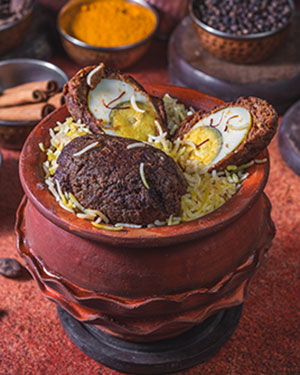
Some Lucknowi locals say this is meant to be eaten with an accompanying gravy called tari. However, chefs deem it a complete dish on its own. This also has certain vegetarian versions such as the Awadhi Palak biryani which is known for its rich aroma and is usually cooked in a Dum Pukht style of cooking.

2. Kolkata biryani – This biryani is all about the potatoes and eggs—with a slight hint of sweetness.
The Calcutta biryani is distinguished by its yellow rice, which is soaked in saffron and kewra water and, no matter what culinary historians say, it is simply one of the best versions of biryani to ever exist. It has evolved into an entity of its own from its Awadhi counterpart. Containing meat cooked in yoghurt, this biryani has potatoes and boiled eggs, along with a touch of sweetness thanks to cinnamon and nutmeg. This addition of the potato to the biryani was said to be an improvisation by the royal bawarchis at the kitchens of Wajid Ali Shah when we shifted his base from Lucknow to Metiabruz at Kolkata.

3. Yakhni Biryani – Yakhni is a yoghurt and saffron based mutton broth made using meat and a host of aromatic spices. The spice list includes fennel seeds, dry ginger powder, cloves, cinnamon, black and green cardamom. Yoghurt acts as the binding agent in this preparation, bringing the flavours together, lending a unique flavour to this biryani.
Yakhni is a staple in the Kashmiri cuisine and has arrived in India through the Afghan and Pakisthani culture and spices. This is also known for its distinct taste that is highly popular among food lovers. Afghanistan is the birthplace of the highly regarded Murgh Yakhni Biryani. Legend goes, an Afghan King once visited the barracks of this own army and found them semi-famished and woefully under-nourished, he immediately ordered his imperial rakabdars to cook them a vegetarian version of the Yakhni Biryani, also known as the Yakhni Pulau.

4. Purdah Biryani – The Purdah Biryani is made by the “Dum-Pukht” or the dum-cooking style, one of the oldest cooking methods that date back to the 1500s. The book “Ain-i Akbari” abour Akbar the Great describes the various cooking styles and the secret recipes of the royal kitchen. “Dumpukht” in Persian means “air-cooked” or baked. The “Purdah” is made with whole wheat flour, salt, fennel, cumin, a pinch of turmeric, saffron, warm water, and ghee. However, a different Mughal, Nawab Asaf-ud-Daulah of Awadh made this recipe famous in the 1700s.
The Awadhi delicacy is a slow cooked meal, which when opened, the aroma of spices fill the air, the meat in this Biryani is so tender that it falls off the bones and the other ingredients along with rice make a complete mouth-watering gumbo of deliciousness.

5. Moti Biryani – Moti Biryani has its roots firmly in History. It was one of the famed royal dishes which the Bawarchis of the Shahi Bawarchi Khana (or the Royal Kitchen) used to prepare regularly for the Nawab. The city of Nazakat, an exuberant paradise for food lovers, in Lucknow, is the birthplace of this Awadhi deliciousness. The Shahi Moti Biryani is one such Shahi feast from the rich past that is abounding the treasure-chest of Awadh , in Lucknow, that could tantalize your taste buds by its sheer description.
This royal dish of the Awadhi Cuisine was famed for the edible pearls or Moti which were then made of eggs and minced meat, given the shape of small meat balls wrapped in gold and silver foils by the skilled Bawarchis of yore. With time the appearance of the original dish has changed considerably and the popular versions we get to see these days are much easier to make in any kitchen, however, a food critic of say Gordon Ramsay’s calibre would call it Moti Polau and not Moti Biryani.
The “OG” Moti biryani from the Shahi Bawarchi Khana of Awadh can be found in only a select few restaurants in India.

6. Kofta Biryani – Minced tender and juicy koftas (meatballs) tossed in delicious sauce, layered with flavorful basmati rice and dum-cooked for shorter than usual span is how the Kofta Biryani is usually made. The usage of the correct spices in the right proportions creates a texture that is unmatched and a party of distinctive flavors. This biryani is indeed a “feast for the senses”. This particular biryani goes well with any raita.
These mouth-watering Biryanis make it to the list of the most popular and note-worthy of its variants.
To satiate your understandable biryani craving, order in your favourite biryani from the authentic Awadhi delicacies served at Oudh 1590. Or, as a virtual flier for the religious Biryani lovers, Oudh 1590 is hosting its annual Biryani Festival to honour the late gourmet King, Nawab Wajid Ali Shah! This is the best opportunity for foodies to calm the hunger rumble of their stomach by dropping in for the feast of the year.
16-06-2021

Kebabs have remained an international delicacy over centuries now! What is it about this dish that makes it such a global favourite? What is the origin story of our beloved kebabs and the evolution of their “super”-taste? Read on to find out.
Kebabs as we know it have their roots in Turkey. This is if we go by the usage of the term “kebab”, which originated from the term “Shish – kebab”. “Shish” in Turkish means sword and “keba” means meat; more particularly, lamb or mutton. This particular dish came into being when the soldiers of the Ottoman Empire took to putting small pieces of meat on their swords and over a large fire after sundown in their battle-camps. This barbecued piece of meat was called the shish (sword) kebab (meat).
Now due to the vastness of the Ottoman Empire (cue “The Magnificient Century”, the soap opera), the shish kebabs travelled far and wide. This gave rise to indigenous variants of kebabs across many countries. When it came to India, for the first time, in the 14th century with the Mughals, it was a humble preparation of lightly seasoned meat, cooked over a fire. But India being the hub of spices, it could not retain its humble status for long. Very soon, it evolved into a distinctively regal culinary delicacy, perfected by the royal cooks for the Mughal Emperors.
India did already have its own version of the kebab called the “Maas ka Soola” which was cooked with game meat such as venison and wild boar. But all of these indigenous recipes have evolved significantly under the Mughal rule and the finesse of their royal “bawarchis”.
Till about the 19th century, all kebabs were cooked over horizontally placed skewers and not vertical ones. It was in the 19th century that Turkey gave rise to the doner kebab, traditionally served with bread.
Historically, the marinating process of the kebab varies from the place to place but commonly revolves around a slather of lime juice, yoghurt, onion juice, oil, cinnamon, tomato juice and other ground spices.
Although, the origin of kebab was most probably just cut up pieces of a hunk of freshly killed animal meat cooked over a wood fire with a dash of salt, and maybe some chilli powder added to it. The subtle addition of the myriad flavours, nuanced textures, and a wide taste range was an art form that evolved over a long period of time and is still continuously innovated and experimented upon.
In the 21st century, kebabs have become a high end delicacy served in top-notch restaurants and eateries. Some of the most interesting modern kebabs and their origin are:
1. Tunde and Galawati Kebab - This tender, succulent melt-in-the mouth patty shaped kebab from Lucknow got its unsuspecting name from its creator, Haji Murad Ali. He only had one hand and was locally called Tunday, as is common in colloquial Hindi for people with any arm handicap. Haji Murad, is said to have used 160 spices in his special kebab and had secured the patronage of Nawab Wajid Ali Shah who expressed his wish to eat a kebab that was soft and easy on his toothless mouth. While the local name of the maker was given to the kebab, this soft and tender preparation with certain slight variations is also known as the Galawati kebab because of its sheer tenderness. Unlike most kebabs that are roasted on open flame, these are deep fried in clarified butter.
Galawati means 'soft', a kebab that melts in the mouth, and that was the specific purpose. It is believed that it was Haji Murad, who made the first Galawati Kebab, and gave the court this creamy, rich, mouth-watering delicacy is also accredited with inventing the Moti Polau. Instead of beef, he used the finest portions of lamb, which was finely minced and to it a meat tenderiser (unripe papaya) was added, along with a divine mix of over 160 exotic spices to build the rich, distinct flavour. The minced meat was then given the shape of patties and fried in clarified butter for a delectable finish. Has the talks of Galawati kebabs got you craving for some? You can order in from Oudh 1590, for a safe, hygienic and fast home delivery.

2. Kakori Kebab – The place Kakori is famed not just for the well-known Kakori Conspiracy of 1925, but also the delectable kebabs that are the name-sake of this small town in Uttar Pradesh. Kakori Kabab is one of the most famous dishes of Awadhi cuisine and is known for its moist, soft texture, fragrant flavour and rich aroma. Just like Seekh Kebabs, they too are roasted on skewers and served with Indian breads (usually, naan). In fact, they have evolved as a softer, more tender version of Seekh kebabs which were already in peak popularity in Awadh.
Legend goes, a local lord of Lucknow, in the Kakori district, Nawab Syed Haider Kazmi, arranged a dinner party for some of his British colleagues during the mango season. The Nawab served the very best of Awadhi cuisine for his British friends, including the immensely popular Seekh kebabs. His lavish hospitality took a severe setback when a certain British official made a hurtful remark about the hard, chewy texture of the Seekh Kebabs.
This offended the Nawab greatly, and he asked his Rakabdars and Khansamas to immediately design a tender version of Seekh kebabs. The royal cooks then spent several days and nights in the palace kitchen to curate a more refined variant of the Seekh kebabs and then after about ten days of rigourous experimentation and wild inventions, they finalised the recipe of what are now popularly known as the Kakori Kebabs.
These kebabs has a very refined, soft and smooth texture. The usage of 'Maliabali' mangoes to tenderise the meat and a blend of eclectic spices, was the secret behind the softness of these kebabs and their distinct flavour. It was after this that the Kakori Kebabs rose to fame. Crossing the boundary-lines of Kakori, these kebabs became popular in the entire region of Awadh, and popularised the art of using raw fruits (such as raw mango and papaya) as meat tenderizers in kebab recipes. Kakori kebabs are a great option for a family dinner or lunch.

3. Shami Kebab - A very popular kebab in India, Pakistan and Bangladesh, the Shami kebab is made with meat, chickpeas and egg. Eaten as a snack, and a starter or an appetizer, the kebab dates back to the Mughal era when Syrian cooks invented it in the emperor's kitchen. Bilad-al Shaam was the historical name of Syria, the kebab derives its name from there.
These three make the most popular list of modern kebabs with the richest of history and also taste. If this journey of kebab through the ages ignites the hunger-fire of the inner Nawab in you, order in your favourite kebabs from the authentic Awadhi delicacies served at Oudh 1590.